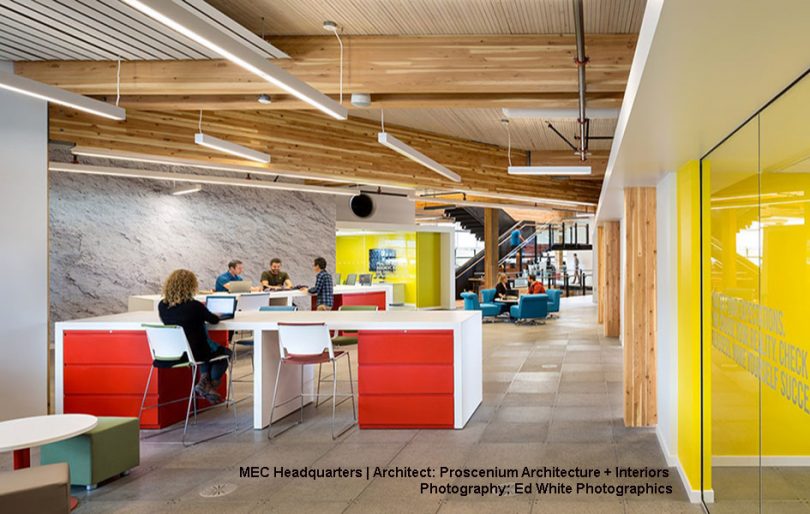Architects are calling for a return to wood as a principal building material. As the use of solid or engineered wood for load bearing structures and interior finishing is proving to be a sustainable alternative to concrete and steel construction for multi-family, commercial and institutional buildings, mass timber is becoming a ‘market disrupter’ in Canada.
Mass timber is the next big step in green buildings. The benefits of mass timber include its ease of construction, light carbon footprint, positive effects on human health and well-being, and better organizational performance. This research is summarized in my report on Wood, Well-being and Performance: The Human and Organizational Benefits of Wood Buildings.
Increasingly, employers recognize that promoting employee well-being ultimately contributes to humanly sustainable improvements in business performance. Mounting evidence now highlights how the physical workspace contributes to organizational performance when employees are healthier and more engaged.
Wood is one of the few natural building materials that can simultaneously achieve four important goals: reduced carbon emissions; increased sustainability in a building’s life cycle; improved occupant well-being; and increased organizational benefits from having happier, healthier and more productive employees.
Corporate sustainability strategies are starting to align with human resource goals. ‘Green human resource management’ is an emerging trend. This views employers’ sustainability actions and branding as useful for achieving their employee recruitment, retention, and engagement goals. Employers who adopt wood as the main structural and interior design material for a new building stand to reap additional human resource benefits, given wood’s strong green credentials.
The strongest evidence of wood’s human and organizational benefits is based on wood’s biophilic properties. Biophilia refers to humans’ innate need for connections to nature. When individuals have contact with nature, their neurological, physiological, and psychological responses result in less stress, lower blood pressure, more relaxation and positive moods, and increased concentration.
The organizational benefits of biophilia include reduced employer costs and increased productivity based on the following employee outcomes: reduced illness, absenteeism and presenteeism; increased retention; increased job performance; and reduced stress and fatigue.
Important human benefits of wood interiors include better indoor air quality because of wood’s hypoallergenic properties, reduced off-gassing of harmful volatile organic substances, and better sound absorption.
Studies document that wood interior design is associated with higher occupant satisfaction. Furthermore, wood surfaces in an office environment can reduce the body’s stress responses. Mass timber buildings benefit workers involved in the construction process because of reduced construction time and safer, cleaner building sites.
Employers stand to benefit from employee well-being and job performance improvements that come from using wood in building construction and interior design. For building owners, this can translate into increased building value and rents.
Graham Lowe has over 30 years of organizational, labour market and policy consulting experience across Canada and internationally. He is president of The Graham Lowe Group Inc., a workplace consulting and research firm, and a Professor Emeritus at the University of Alberta.










Hi Graham Lowe. First of all, congratulations for this research. It’s very good. I’m a Portuguese architect who tries to show the benefits of wood construction / mass timber construction benefits for the Portuguese people, constructors, architects, engineers, specially for clients who wants to build a house or other type of building.
I’m sending this message to ask you, if you don’t mind that I translate some parts of your research and publish and share in my social network (LinkedIn, Facebook, Instagram).
Thank you very much, and continue with the very good work.
Please contact him at http://www.grahamlowe.ca.